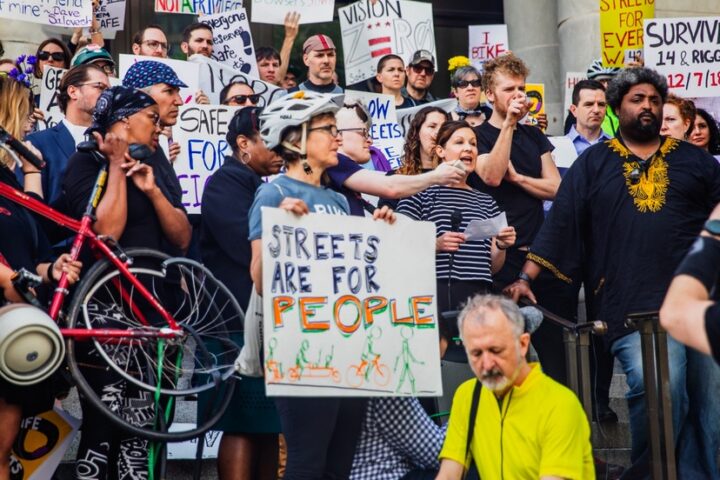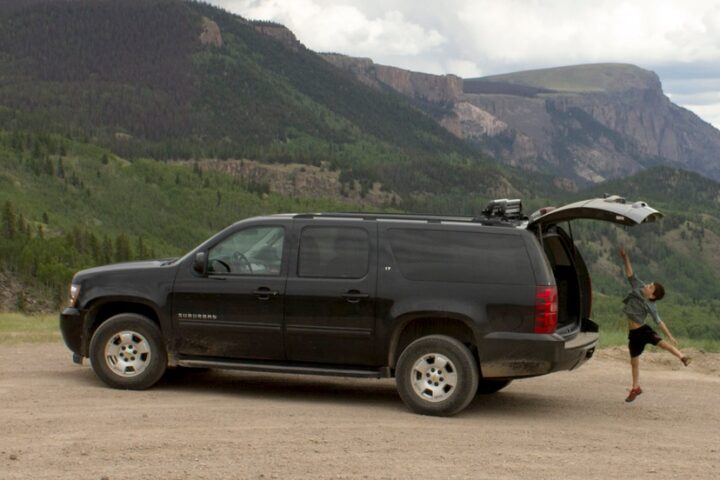This op-ed by Sammy Herdman appeared on Colorado Newsline on July 2, 2024.
Colorado’s tragically high number of pedestrian and cyclist fatalities in 2023 inspired lawmakers to introduce a variety of bills aimed at improving safety and mobility options for vulnerable road users.
Many passed, continuing the Legislature’s trend of supporting bike, pedestrian, and transit laws.
One bill, however, was killed shortly after it was introduced. The Vulnerable Road User Protection Enterprise would have done more than generate an impressive $18 million for bike and pedestrian infrastructure annually; it also would have counteracted the perverse federal incentives driving up traffic fatalities and undermining emission reduction efforts.
The high rate of traffic fatalities in Colorado is in part caused by the distinctly American phenomenon of supersized vehicles. On average, cars sold in the United States are 20% larger than those in Europe. The federal government classifies most of these large cars as light trucks. Once, the light truck classification differentiated regular passenger vehicles from work trucks owned by farms and businesses. Now, light trucks comprise 80% of car sales in the U.S. and includes pick-up trucks, SUVs and even standard vehicles with the right trim, like a Toyota RAV-4 with four-wheel drive.
The boom in light truck popularity carries a high social cost: Light truck collisions with pedestrians are 70% more likely to be fatal, and are also more deadly for cyclists.

The Vulnerable Road User Protection Enterprise would have raised millions each year for safe pedestrian and cyclist infrastructure projects by introducing a novel fee structure based on vehicle size. All non-commercial light trucks would be subject to a higher fee than regular cars, payable during vehicle registration. The minimum fee would have been just $3 for passenger cars weighing between 3,500 and 4,499 pounds. The maximum fee would have been $43.60, levied upon owners of light trucks weighing more than 9,500 pounds. The stated goal of the fee structure was to generate funding, but it also would have provided a disincentive to buy deadly light trucks in Colorado.
Three outdated federal policies are often blamed for the predominance of light trucks on American roads. The 1984 “Hummer Deduction” incentivizes American consumers to purchase vehicles greater than 6,000 pounds because they may be eligible for a nearly $30,000 tax break if the car is used for business. To meet demand for this tax break, automakers intentionally design larger vehicles, reducing consumer options for mid-sized cars.
The last active remnant of the 1964 Chicken Tax is a 25% tariff on imported light trucks, essentially shutting foreign automakers out of the American light truck market. Without foreign competition, American automakers are able to sell trucks at less competitive prices, incentivizing them to market behemoth vehicles to American citizens.
Finally, the Light Truck Loophole allows light trucks to have worse gas mileage than regular passenger vehicles. To skirt fuel economy and tailpipe emission regulations, automakers have aggressively marketed large vehicles — resulting in more gas guzzlers that burn holes in consumer’s pockets and in our atmosphere.

Transportation is the greatest source of carbon emissions in Colorado, and it’s also the primary source of the Front Range’s harmful ground-level ozone pollution. If it weren’t for the steady increase in light trucks over the past several decades, the nation’s fleet of vehicles would have significantly better fuel economy — one study found that fuel economy would have improved 50% between 1980 and 2006; instead, it improved by only 15%. Even the Biden administration’s progressive new vehicle emission regulations, which will go into effect between 2027 and 2032, allow light trucks to pollute more.
Colorado has ambitious greenhouse gas emission reduction goals, and more than 40 communities in Colorado are committed to Vision Zero — a goal to reach zero annual traffic fatalities. Yet both initiatives are falling short. The Vulnerable Road User Protection Enterprise targeted one of the underlying obstacles to Vision Zero and Colorado’s climate goals: the incentives to buy and sell light trucks.
Alone, the bill’s modest fee structure couldn’t have fully counteracted the federal incentives, but it would have been a bold step in the right direction. Light truck owners would have had to chip in for the burden that dangerous and dirty light trucks place on society.
Hopefully, the failed Vulnerable Road User Protection Enterprise was only one iteration of a policy to disincentivize light trucks, and not the last.
Sammy Herdman is an environmental policy and management graduate student at the University of Denver and a program coordinator with the Regional Air Quality Council.

